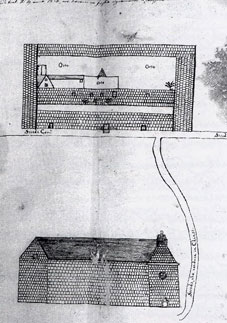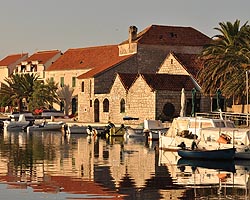History of Sućuraj on the island of Hvar
 Greco-Italic helmet, 4th century B.C. Greco-Italic helmet, 4th century B.C.- founded near Sućuraj |
 Amphorae from sunken roman Amphorae from sunken romangalleys - founded near Sućuraj |
 Part of queen Teuta wall Part of queen Teuta wallin Sućuraj |
 Monastery of St. August Monastery of St. Augustfrom 9th century |
 Schematic report of the old parish Schematic report of the old parishchurch and monastery from the 13th century |
 Drawing of the Sucuraj harbour Drawing of the Sucuraj harbourand fort from 1635 |
 Fort Fortica from 1613 Fort Fortica from 1613 |
 Church of St. Anthony from 1663 Church of St. Anthony from 1663 |
Sućuraj has been devastated and rebuilt several times during its history. The first known inhabitants were Illyrians, and during 7th and 8th century Croatians settled in and have been living here ever since. Many different invaders stamped their authority on Sucuraj, throughout ancient history as well as more recent times: Illyrians, Romans, Croatians, Hungarians, Venetians, French, Austrians, Italians...During the 20th century alone Sućuraj was a part of 6 different countries.
The oldest archeological finding, which gives evidence about early human presence, is a stone axe with an opening for the bracket, dating in the transition period from the Copper Age to Bronze Age and it is currently being archived in the Archeological museum in Split. From that era are also graves shaped like stone chests found on a site near Sućuraj called Umić. There has been evidence of contact with the Hellenistic culture found in shape of ceramics located in the Mlaska bay and Sućuraj port (3rd to 2nd century BC).
According to legend, the court of Illyric queen Teuta was located on the site Koščak-Oglavak near Sućuraj. She rained from 231 to 219 BC and waged war against the Romans. In favor of the legend of queen Teuta speaks a wall known as Teuta's wall and many amphorae from sunken roman galleys found on the ocean floor around the town. Ancient Illyric cemetery "Velika gomila" also gives evidence of Illyric presence. In the rectory treasury in Sućuraj there is a large fraction of white roman mosaic found on the site of present day monastery, while on the area Brigovi near Mlaska bay there are remains of roman Villa rustica with a cistern. According to historical sources these are the remains of two roman settlements.
Traditional name for Sućuraj's port is "pirate port". It has gotten its name thanks to people of Neretva Valley, one of Croatian tribes who came to the sea from the North in the 7th century. They populated the area in the Neretva Valley and Makarska's coats and very quickly became skilled seamen and pirates. Sućuraj's deep and hidden port was ideal for them. During that period, people lived on the western edge of the fields surrounding the port and perhaps in before mentioned roman settlements.
The oldest structure in Sućuraj is a monastery of Augustin's monks, probably built in 9th century and in use to this day. The monastery itself was crashed down and rebuilt several times. The sing on the main entrance tells that it was renovated in the 1309. Dating from that period are the foundations of old church dedicated to Saint George (in Croatian Sveti Juraj) from which the town got its name (Sut + Juraj = Sućuraj). The church was mentioned in the bylaw of the city of Hvar in 1331, and it was demolished due to frazzle in the late 19th century. In the vicinity of the old church new St. George's church was built.
Very turbulent period in its history Sućuraj has had from the late 15th to early 17th century, during the Venetian-Ottoman wars. Sućuraj was on the frontier of three countries. The town itself was a part of Venetian Republic, the Ottomans occupied the coastline and Pelješac peninsula was a part of Dubrovnik Republic. Many people came from the mainland fleeing the Ottomans and arrived to Sućuraj. The Ottomans attack and destroy the town on several occasions and that resulted in the building of a fort called Fortica in 1613 which is partly preserved today but was damaged in the WWII. After that the Ottomans were no longer a serious threat and the town started to develop since. Due to the occupation of Makarska's coastline, the bishop of Makarska, father Bartul Kačić Žarković, presided there. In the 17th century the bishop had the Bishop's palace built in Sućuraj but it was destroyed in the WWII, with only foundations remaining today. Immigrants from the mainland, led by Franciscans settle in the area Donja Banda, which wasn't populated by that time and they build Saint Anthony's in 1663 (preserved to this day).
In the beginning of the 19th century Sućuraj came under French rule. By the Napoleon decree from 1881 Municipality of Sućuraj was founded and this began the construction of the new cemetery (today the old one), road to the town of Hvar and street lighting was introduced. After the defeat of Napoleon, Sućuraj comes under Austrian rule. In 1817 elementary school was founded and the economy starts to develop rapidly. The post office opens in 1868 and the telegraph was introduced in 1871. Several important objects were built in the coming years: breakwater in a part of the seafront in 1870, new buildings of town hall and elementary school in 1888 (both destroyed in WWII), the lighthouse in 1889 and new church dedicated to St. George in 1897.
In the late 19th century due to an outburst of phylloxera(a disease of vines) during a few year spend almost all of the vines died. Because the viticulture (vine growing) was the most important economical area, people were suddenly left with no income, so many of them emigrate to the Americas, Australia and New Zeland in the beginning of the 20th century. After the First World War, Sućuraj was briefly a part of the Kingdom of Italy and in 1921 becomes a part of the Kingdom of Serbs, Croats and Slovenians (later the Kingdom of Yugoslavia). Although the economy was slow in its recovery during the crisis, in 1938 a sardine factory began work and was operational until 1971.
Sućuraj had its difficult time during WWII, when the town was almost completely destroyed in the bombings and the population went to war or was exiled. After the war Sućuraj becomes a part of Federal Republic of Yugoslavia, most of its inhabitants came back and the town begins to recover in spite of hardship. But due to poor economical situation, the emigration process to overseas countries continues. Faster development began during the 1960's: in 1961 the road to the city of Hvar was finished and electricity from the mainland reached the town (via the island of Brač and the electrical substation in the town of Stari Grad), in 1963 the ferry line Sućuraj-Drvenik began to operate and in 1969 the read to Hvar was paved. The tourist development started in the 1970's: new houses are being built and old ones renovated, in 1970 hotel Perna and in 1974 new ferry port were built and in 1978 car camp Mlaska opened. In the year 1986 large problem of water provision was resolved by the water supply arriving from the mainland.
In 1991 Republic of Croatia became an independent country. In the imposed Croatian War of Independence Sućuraj wasn't damaged. The municipality of Sućuraj was terminated in 1963 when the whole island of Hvar became a single municipality, but was reinstated in 1992. In 1994 the monastery was also rebuilt. In 1999 underwater optical cable was installed, which improved the quality of telephone lines and this also made fast internet connection possible, which was realised in 2008. Connection to the mainland power grid via Stari Grad was unreliable with many interruptions and voltage droppings therefore the new underwater transmission cable between Sućuraj and Drvenik was placed in 2002 which resolved the problems of power supply. Between 2005 and 2008 substantial work has been done on the sewerage system and a purifying device was installed. In the early years of the 21st century the port was edited and expanded with new nautical docks. Tourism recovered from the troubles of the last war, and private accommodation improved drastically.
For more details on the history of Sućuraj visit the following links:
1. Antique Sućuraj (Illyrians and Romans)
2. Sućuraj in the Middle Ages (arrival of Croatians)
3. Sućuraj during Venetians (fighting the Ottomans)
4. Sućuraj in the 19th century (Austria, France and the Austria-Hungary kingdom)
5. Sućuraj in the 20th century (3 wars, 6 states)








 English
English  Hrvatski
Hrvatski  Deutsch
Deutsch  Italiano
Italiano  Polski
Polski  Čeština
Čeština  Slovenčina
Slovenčina  Slovenščina
Slovenščina 









